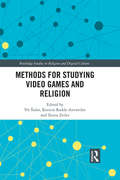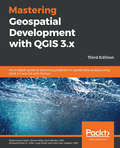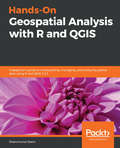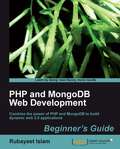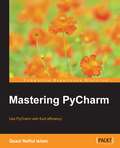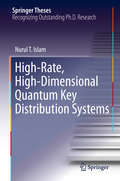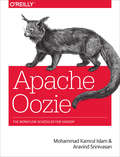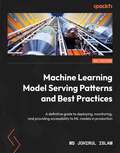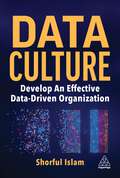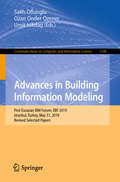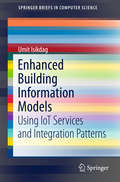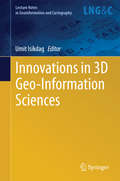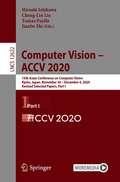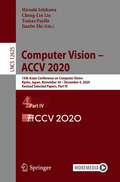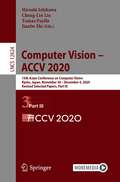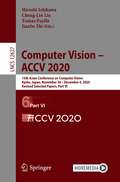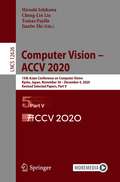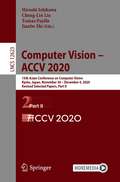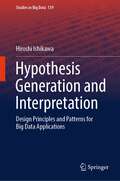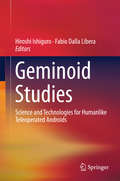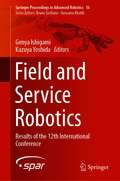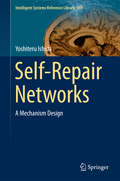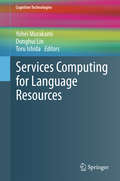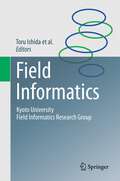- Table View
- List View
Methods for Studying Video Games and Religion (Routledge Studies in Religion and Digital Culture)
by Vít Šisler Kerstin Radde-Antweiler Xenia ZeilerGame studies has been an understudied area within the emerging field of digital media and religion. Video games can reflect, reject, or reconfigure traditionally held religious ideas and often serve as sources for the production of religious practices and ideas. This collection of essays presents a broad range of influential methodological approaches that illuminate how and why video games shape the construction of religious beliefs and practices, and also situates such research within the wider discourse on how digital media intersect with the religious worlds of the 21st century. Each chapter discusses a particular method and its theoretical background, summarizes existing research, and provides a practical case study that demonstrates how the method specifically contributes to the wider study of video games and religion. Featuring contributions from leading and emerging scholars of religion and digital gaming, this book will be an invaluable resource for scholars in the areas of digital culture, new media, religious studies, and game studies across a wide range of disciplines.
Smart Healthcare System Design: Security and Privacy Aspects (Advances in Learning Analytics for Intelligent Cloud-IoT Systems)
by Sk Hafizul Islam Debabrata SamantaThe purpose of this book is to help achieve a better integration between the work of researchers and practitioners in a single medium for capturing state-of-the-art IoT solutions in healthcare applications to address how to improve the proficiency of wireless sensor networks (WSNs) in healthcare. It explores possible automated solutions in everyday life, including the structures of healthcare systems built to handle large amounts of data, thereby improving clinical decisions; which is why this book will prove invaluable to professionals who want to increase their understanding of recent challenges in the IoT-enabled healthcare domain. The 14 chapters address various aspects of the IoT system, such as design challenges, theory, various protocols, and implementation issues, and also include several case studies. Smart Healthcare System: Security and Privacy Aspects covers the introduction, development, and applications of smart healthcare models that represent the current state-of-the-art of various domains. The primary focus will be on theory, algorithms, and their implementation targeted at real-world problems. It will deal with different applications to give the practitioner a flavor of how IoT architectures are designed and introduced into various situations. More particularly, this volume consists of 14 chapters contributed by authors well-versed in the subject who are devoted to reporting the latest findings on smart healthcare system design.
Mastering Geospatial Development with QGIS 3.x: An in-depth guide to becoming proficient in spatial data analysis using QGIS 3.4 and 3.6 with Python, 3rd Edition
by Shammunul Islam Simon Miles GISP Menke GISP Smith Jr. Luigi Pirelli John Van Hoesen, GISP,Go beyond the basics and unleash the full power of QGIS 3.4 and 3.6 with practical, step-by-step examples Key Features One-stop solution to all of your GIS needs Master QGIS by learning about database integration, and geoprocessing tools Learn about the new and updated Processing toolbox and perform spatial analysis Book Description QGIS is an open source solution to GIS and widely used by GIS professionals all over the world. It is the leading alternative to proprietary GIS software. Although QGIS is described as intuitive, it is also, by default, complex. Knowing which tools to use and how to apply them is essential to producing valuable deliverables on time. Starting with a refresher on the QGIS basics and getting you acquainted with the latest QGIS 3.6 updates, this book will take you all the way through to teaching you how to create a spatial database and a GeoPackage. Next, you will learn how to style raster and vector data by choosing and managing different colors. The book will then focus on processing raster and vector data. You will be then taught advanced applications, such as creating and editing vector data. Along with that, you will also learn about the newly updated Processing Toolbox, which will help you develop the advanced data visualizations. The book will then explain to you the graphic modeler, how to create QGIS plugins with PyQGIS, and how to integrate Python analysis scripts with QGIS. By the end of the book, you will understand how to work with all aspects of QGIS and will be ready to use it for any type of GIS work. What you will learn Create and manage a spatial database Get to know advanced techniques to style GIS data Prepare both vector and raster data for processing Add heat maps, live layer effects, and labels to your maps Master LAStools and GRASS integration with the Processing Toolbox Edit and repair topological data errors Automate workflows with batch processing and the QGIS Graphical Modeler Integrate Python scripting into your data processing workflows Develop your own QGIS plugins Who this book is for If you are a GIS professional, a consultant, a student, or perhaps a fast learner who wants to go beyond the basics of QGIS, then this book is for you. It will prepare you to realize the full potential of QGIS.
Hands-On Geospatial Analysis with R and QGIS: A beginner’s guide to manipulating, managing, and analyzing spatial data using R and QGIS 3.2.2
by Shammunul IslamPractical examples with real-world projects in GIS, Remote sensing, Geospatial data management and Analysis using the R programming languageKey FeaturesUnderstand the basics of R and QGIS to work with GIS and remote sensing dataLearn to manage, manipulate, and analyze spatial data using R and QGISApply machine learning algorithms to geospatial data using R and QGISBook DescriptionManaging spatial data has always been challenging and it's getting more complex as the size of data increases. Spatial data is actually big data and you need different tools and techniques to work your way around to model and create different workflows. R and QGIS have powerful features that can make this job easier.This book is your companion for applying machine learning algorithms on GIS and remote sensing data. You’ll start by gaining an understanding of the nature of spatial data and installing R and QGIS. Then, you’ll learn how to use different R packages to import, export, and visualize data, before doing the same in QGIS. Screenshots are included to ease your understanding.Moving on, you’ll learn about different aspects of managing and analyzing spatial data, before diving into advanced topics. You’ll create powerful data visualizations using ggplot2, ggmap, raster, and other packages of R. You’ll learn how to use QGIS 3.2.2 to visualize and manage (create, edit, and format) spatial data. Different types of spatial analysis are also covered using R. Finally, you’ll work with landslide data from Bangladesh to create a landslide susceptibility map using different machine learning algorithms.By reading this book, you’ll transition from being a beginner to an intermediate user of GIS and remote sensing data in no time.What you will learnInstall R and QGISGet familiar with the basics of R programming and QGISVisualize quantitative and qualitative data to create mapsFind out the basics of raster data and how to use them in R and QGISPerform geoprocessing tasks and automate them using the graphical modeler of QGISApply different machine learning algorithms on satellite data for landslide susceptibility mapping and predictionWho this book is forThis book is great for geographers, environmental scientists, statisticians, and every professional who deals with spatial data. If you want to learn how to handle GIS and remote sensing data, then this book is for you. Basic knowledge of R and QGIS would be helpful but is not necessary.
PHP and MongoDB Web Development Beginner’s Guide
by Rubayeet IslamThe book follows a "Code first, explain later" approach, using practical examples in PHP to demonstrate unique features of MongoDB. This book is packed with step-by-step instructions and practical examples, along with challenges to test and improve your knowledge. This book assumes that you are experienced in web application development using PHP, HTML, and CSS. Having working knowledge of using a relational database system such as MySQL will help you grasp some of the concepts quicker, but it is not strictly mandatory. No prior knowledge of MongoDB is required.
Mastering PyCharm
by Quazi Nafiul IslamUse PyCharm with fluid efficiency to write idiomatic python codeAbout This BookUnderstand how PyCharm works and how you can leverage its strength to develop applications quicklyMaster PyCharm's editor to get a fast workflowFull of examples and illustrations that focus on the practical aspects of using PyCharmWho This Book Is ForIf you know PyCharm but want to understand it better and leverage its more powerful but less obvious tool set, this is the book for you. Serving as a launch pad for those who want to master PyCharm and completely harness its best features, it would be helpful if you were familiar with some of Python's most prominent tools such as virtualenv and Python's popular docstring formats such as reStructuredText and EpyType.What You Will LearnUnderstand the internal workings of the IntelliJ PlatformLeverage PyCharm's powerful search tools, and learn which ones are the best for you and your workflowCustomize PyCharm's enhanced Python interpreter and its inbuilt terminalDevelop web applications quickly and easily with different frameworks such as Flask and DjangoUnderstand how code completion works in PyCharm for Python and JavaScriptMake calls to external tools, and use PyCharm macros to your advantageIn DetailPyCharm is addictive, with powerful and configurable code completion, superb editing tools, top-notch support, diverse plugins, and a vibrant ecosystem to boot. Learning how PyCharm works and maximising the synergy of its powerful tools will help you to rapidly develop applications.From leveraging the power of the editor to understanding PyCharm's internals, this book will give you a comprehensive view of PyCharm and allow you to make your own choices about which workflow and tools are best for you.You will start by getting comfortable with PyCharm and making it look exactly like you want. You can customize the tools and taskbars to suit individual developers' coding styles. You also learn how to assign keyboard shortcuts. You will master debugging by inserting breakpoints, collecting runtime data, and debugging from the console. You will understand how PyCharm works underneath and how plugins such as Codemap, Vim, Bitbucket, Assets compressor, markdown, bash file, shortcut translator, and .gitignore leverage the power of the IntelliJ platform.You will become comfortable using the VCS interface in PyCharm and see the benefits of using it for some simple tasks as well as some more complex tasks such as partial commits using changelists.You will take an in-depth look at the various tools in PyCharm, improving your workflow drastically. Finally, you will deploy powerful PyCharm tools for Django, Flask, GAE, and Pyramid Development, becoming well acquainted with PyCharm's toolset for web development with popular platforms.Packed with insider tricks, this book will help you boost productivity with PyCharm.Style and approachAn easy-to-follow guide with plenty of examples and screenshots. Each topic starts off with the goal of enhancing or changing a part of PyCharm to make it suit your needs.
High-Rate, High-Dimensional Quantum Key Distribution Systems (Springer Theses)
by Nurul T. IslamThis book describes a broad research program on quantum communication. Here, a cryptographic key is exchanged by two parties using quantum states of light and the security of the system arises from the fundamental properties of quantum mechanics. The author developed new communication protocols using high-dimensional quantum states so that more than one classical bit is transferred by each photon. This approach helps circumvent some of the non-ideal properties of the experimental system, enabling record key rates on metropolitan distance scales. Another important aspect of the work is the encoding of the key on high-dimensional phase-randomized weak coherent states, combined with so-called decoy states to thwart a class of possible attacks on the system. The experiments are backed up by a rigorous security analysis of the system, which accounts for all known device non-idealities. The author goes on to demonstrate a scalable approach for increasing the dimension of the quantum states, and considers attacks on the system that use optimal quantum cloning techniques. This thesis captures the current state-of-the-art of the field of quantum communication in laboratory systems, and demonstrates that phase-randomized weak coherent states have application beyond quantum communication.
Apache Oozie
by Mohammad Kamrul Islam Aravind SrinivasanGet a solid grounding in Apache Oozie, the workflow scheduler system for managing Hadoop jobs. With this hands-on guide, two experienced Hadoop practitioners walk you through the intricacies of this powerful and flexible platform, with numerous examples and real-world use cases.Once you set up your Oozie server, you'll dive into techniques for writing and coordinating workflows, and learn how to write complex data pipelines. Advanced topics show you how to handle shared libraries in Oozie, as well as how to implement and manage Oozie's security capabilities.Install and configure an Oozie server, and get an overview of basic conceptsJourney through the world of writing and configuring workflowsLearn how the Oozie coordinator schedules and executes workflows based on triggersUnderstand how Oozie manages data dependenciesUse Oozie bundles to package several coordinator apps into a data pipelineLearn about security features and shared library managementImplement custom extensions and write your own EL functions and actionsDebug workflows and manage Oozie's operational details
Machine Learning Model Serving Patterns and Best Practices: A definitive guide to deploying, monitoring, and providing accessibility to ML models in production
by Md Johirul IslamBecome a successful machine learning professional by effortlessly deploying machine learning models to production and implementing cloud-based machine learning models for widespread organizational useKey FeaturesLearn best practices about bringing your models to productionExplore the tools available for serving ML models and the differences between themUnderstand state-of-the-art monitoring approaches for model serving implementationsBook DescriptionServing patterns enable data science and ML teams to bring their models to production. Most ML models are not deployed for consumers, so ML engineers need to know the critical steps for how to serve an ML model. This book will cover the whole process, from the basic concepts like stateful and stateless serving to the advantages and challenges of each. Batch, real-time, and continuous model serving techniques will also be covered in detail. Later chapters will give detailed examples of keyed prediction techniques and ensemble patterns. Valuable associated technologies like TensorFlow severing, BentoML, and RayServe will also be discussed, making sure that you have a good understanding of the most important methods and techniques in model serving. Later, you'll cover topics such as monitoring and performance optimization, as well as strategies for managing model drift and handling updates and versioning. The book will provide practical guidance and best practices for ensuring that your model serving pipeline is robust, scalable, and reliable. Additionally, this book will explore the use of cloud-based platforms and services for model serving using AWS SageMaker with the help of detailed examples. By the end of this book, you'll be able to save and serve your model using state-of-the-art techniques.What you will learnExplore specific patterns in model serving that are crucial for every data science professionalUnderstand how to serve machine learning models using different techniquesDiscover the various approaches to stateless servingImplement advanced techniques for batch and streaming model servingGet to grips with the fundamental concepts in continued model evaluationServe machine learning models using a fully managed AWS Sagemaker cloud solutionWho this book is forThis book is for machine learning engineers and data scientists who want to bring their models into production. Those who are familiar with machine learning and have experience of using machine learning techniques but are looking for options and strategies to bring their models to production will find great value in this book. Working knowledge of Python programming is a must to get started.
Data Culture: Develop An Effective Data-Driven Organization
by Dr Shorful IslamOrganizations often start their data journey by either procuring the technology or hiring the people. However, without an effective data-driven culture in place, they can struggle to derive value from their investments.Data Culture explores how data leaders can develop and nurture a data-driven culture tailored to their organization's needs. It outlines the types of data leadership and teams needed and the key building blocks for success, such as team recruitment, building and training, leadership, process, behavioural change management, developing, sustaining and measuring a data culture, company values and everyday decision making. It also explores the nuances of how different types of data cultures work with different types of companies, what to avoid and the differences between building a data culture from scratch and changing an existing data culture from within.With this hands-on guide, senior data leader Shorful Islam takes readers through how to successfully establish or change a data culture, sharing his expertise in behavioural change psychology and two decades of experience in fostering data culture in organizations. Supported throughout by real-world examples and cases, this will be an essential read for all data leaders and anyone involved in developing a data-driven organizational culture.
Advances in Building Information Modeling: First Eurasian BIM Forum, EBF 2019, Istanbul, Turkey, May 31, 2019, Revised Selected Papers (Communications in Computer and Information Science #1188)
by Umit Isikdag Salih Ofluoglu Ozan Onder OzenerThis book constitutes the refereed proceedings of the First Eurasian BIM Forum, EBF 2019, held in Istanbul, Turkey, in May 2019. The 16 full papers were carefully reviewed and selected from 44 submissions. The papers cover such topics as BIM adoption and implementation; BIM for project management; BIM for sustainability and performative design; BIM and facility management and infrastructural issues.
Enhanced Building Information Models
by Umit IsikdagThis book explains how to combine and exploit sensor networks and internet-of-things (IoT) technologies and Web-service design patterns to enrich and integrate Building Information Models (BIMs). It provides approaches and software architectures for facilitating the interaction with (and between) BIMs through Web services, and for enabling and facilitating the fusion of the information residing in such models or of information acquired from IoT technologies. The proposed software architectures are presented in the form of design patterns. This information fusion will facilitate many novel application fields ranging from emergency response, to urban monitoring and surveillance, and to smart buildings. The book consists of 8 chapters. The first 2 chapters focus on the basics of BIMs, while chapter 3 presents fundamental service-oriented architecture patterns for complex information models. Subsequently, chapters 4 and 5 elaborate on the hardware and software side of IoT, with a special focus on their use for BIMs. Chapter 6 provides advanced SOA patterns for BIMs, while chapter 7 details patterns for IoT, and for BIM and IoT information fusion. Lastly, chapter 8 summarizes the work and provides an outlook on promising future developments. Overall, the book will be beneficial for researchers and developers in the fields of building information models, IoT applications, and systems integration.
Innovations in 3D Geo-Information Sciences
by Umit Isikdag3D GeoInfo aims to bring together international state-of-the-art research and facilitate the dialogue on emerging topics in the field of 3D geo-information. The conference offers an interdisciplinary forum in the fields of 3D data collection and modeling; reconstruction and methods for 3D representation; data management for maintenance of 3D geo-information or 3D data analysis and visualization. The book covers the best papers from 3D GeoInfo held in Istanbul in November 2013.
Computer Vision – ACCV 2020: 15th Asian Conference on Computer Vision, Kyoto, Japan, November 30 – December 4, 2020, Revised Selected Papers, Part I (Lecture Notes in Computer Science #12622)
by Hiroshi Ishikawa Cheng-Lin Liu Tomas Pajdla Jianbo ShiThe six volume set of LNCS 12622-12627 constitutes the proceedings of the 15th Asian Conference on Computer Vision, ACCV 2020, held in Kyoto, Japan, in November/ December 2020.*The total of 254 contributions was carefully reviewed and selected from 768 submissions during two rounds of reviewing and improvement. The papers focus on the following topics: Part I: 3D computer vision; segmentation and grouping Part II: low-level vision, image processing; motion and tracking Part III: recognition and detection; optimization, statistical methods, and learning; robot vision Part IV: deep learning for computer vision, generative models for computer vision Part V: face, pose, action, and gesture; video analysis and event recognition; biomedical image analysis Part VI: applications of computer vision; vision for X; datasets and performance analysis *The conference was held virtually.
Computer Vision – ACCV 2020: 15th Asian Conference on Computer Vision, Kyoto, Japan, November 30 – December 4, 2020, Revised Selected Papers, Part IV (Lecture Notes in Computer Science #12625)
by Hiroshi Ishikawa Cheng-Lin Liu Tomas Pajdla Jianbo ShiThe six volume set of LNCS 12622-12627 constitutes the proceedings of the 15th Asian Conference on Computer Vision, ACCV 2020, held in Kyoto, Japan, in November/ December 2020.*The total of 254 contributions was carefully reviewed and selected from 768 submissions during two rounds of reviewing and improvement. The papers focus on the following topics: Part I: 3D computer vision; segmentation and grouping Part II: low-level vision, image processing; motion and tracking Part III: recognition and detection; optimization, statistical methods, and learning; robot vision Part IV: deep learning for computer vision, generative models for computer vision Part V: face, pose, action, and gesture; video analysis and event recognition; biomedical image analysis Part VI: applications of computer vision; vision for X; datasets and performance analysis *The conference was held virtually.
Computer Vision – ACCV 2020: 15th Asian Conference on Computer Vision, Kyoto, Japan, November 30 – December 4, 2020, Revised Selected Papers, Part III (Lecture Notes in Computer Science #12624)
by Hiroshi Ishikawa Cheng-Lin Liu Tomas Pajdla Jianbo ShiThe six volume set of LNCS 12622-12627 constitutes the proceedings of the 15th Asian Conference on Computer Vision, ACCV 2020, held in Kyoto, Japan, in November/ December 2020.*The total of 254 contributions was carefully reviewed and selected from 768 submissions during two rounds of reviewing and improvement. The papers focus on the following topics: Part I: 3D computer vision; segmentation and grouping Part II: low-level vision, image processing; motion and tracking Part III: recognition and detection; optimization, statistical methods, and learning; robot vision Part IV: deep learning for computer vision, generative models for computer vision Part V: face, pose, action, and gesture; video analysis and event recognition; biomedical image analysis Part VI: applications of computer vision; vision for X; datasets and performance analysis *The conference was held virtually.
Computer Vision – ACCV 2020: 15th Asian Conference on Computer Vision, Kyoto, Japan, November 30 – December 4, 2020, Revised Selected Papers, Part VI (Lecture Notes in Computer Science #12627)
by Hiroshi Ishikawa Cheng-Lin Liu Tomas Pajdla Jianbo ShiThe six volume set of LNCS 12622-12627 constitutes the proceedings of the 15th Asian Conference on Computer Vision, ACCV 2020, held in Kyoto, Japan, in November/ December 2020.*The total of 254 contributions was carefully reviewed and selected from 768 submissions during two rounds of reviewing and improvement. The papers focus on the following topics: Part I: 3D computer vision; segmentation and grouping Part II: low-level vision, image processing; motion and tracking Part III: recognition and detection; optimization, statistical methods, and learning; robot vision Part IV: deep learning for computer vision, generative models for computer vision Part V: face, pose, action, and gesture; video analysis and event recognition; biomedical image analysis Part VI: applications of computer vision; vision for X; datasets and performance analysis *The conference was held virtually.
Computer Vision – ACCV 2020: 15th Asian Conference on Computer Vision, Kyoto, Japan, November 30 – December 4, 2020, Revised Selected Papers, Part V (Lecture Notes in Computer Science #12626)
by Hiroshi Ishikawa Cheng-Lin Liu Tomas Pajdla Jianbo ShiThe six volume set of LNCS 12622-12627 constitutes the proceedings of the 15th Asian Conference on Computer Vision, ACCV 2020, held in Kyoto, Japan, in November/ December 2020.*The total of 254 contributions was carefully reviewed and selected from 768 submissions during two rounds of reviewing and improvement. The papers focus on the following topics: Part I: 3D computer vision; segmentation and grouping Part II: low-level vision, image processing; motion and tracking Part III: recognition and detection; optimization, statistical methods, and learning; robot vision Part IV: deep learning for computer vision, generative models for computer vision Part V: face, pose, action, and gesture; video analysis and event recognition; biomedical image analysis Part VI: applications of computer vision; vision for X; datasets and performance analysis *The conference was held virtually.
Computer Vision – ACCV 2020: 15th Asian Conference on Computer Vision, Kyoto, Japan, November 30 – December 4, 2020, Revised Selected Papers, Part II (Lecture Notes in Computer Science #12623)
by Hiroshi Ishikawa Cheng-Lin Liu Tomas Pajdla Jianbo ShiThe six volume set of LNCS 12622-12627 constitutes the proceedings of the 15th Asian Conference on Computer Vision, ACCV 2020, held in Kyoto, Japan, in November/ December 2020.*The total of 254 contributions was carefully reviewed and selected from 768 submissions during two rounds of reviewing and improvement. The papers focus on the following topics: Part I: 3D computer vision; segmentation and grouping Part II: low-level vision, image processing; motion and tracking Part III: recognition and detection; optimization, statistical methods, and learning; robot vision Part IV: deep learning for computer vision, generative models for computer vision Part V: face, pose, action, and gesture; video analysis and event recognition; biomedical image analysis Part VI: applications of computer vision; vision for X; datasets and performance analysis *The conference was held virtually.
Hypothesis Generation and Interpretation: Design Principles and Patterns for Big Data Applications (Studies in Big Data #139)
by Hiroshi IshikawaThis book focuses in detail on data science and data analysis and emphasizes the importance of data engineering and data management in the design of big data applications. The author uses patterns discovered in a collection of big data applications to provide design principles for hypothesis generation, integrating big data processing and management, machine learning and data mining techniques. The book proposes and explains innovative principles for interpreting hypotheses by integrating micro-explanations (those based on the explanation of analytical models and individual decisions within them) with macro-explanations (those based on applied processes and model generation). Practical case studies are used to demonstrate how hypothesis-generation and -interpretation technologies work. These are based on “social infrastructure” applications like in-bound tourism, disaster management, lunar and planetary exploration, and treatment of infectious diseases. The novel methods and technologies proposed in Hypothesis Generation and Interpretation are supported by the incorporation of historical perspectives on science and an emphasis on the origin and development of the ideas behind their design principles and patterns. Academic investigators and practitioners working on the further development and application of hypothesis generation and interpretation in big data computing, with backgrounds in data science and engineering, or the study of problem solving and scientific methods or who employ those ideas in fields like machine learning will find this book of considerable interest.
Geminoid Studies: Science And Technologies For Humanlike Teleoperated Androids
by Hiroshi Ishiguro Fabio Dalla LiberaThis book describes the teleoperated android Geminoid, which has a very humanlike appearance, movements, and perceptions, requiring unique developmental techniques. The book facilitates understanding of the framework of android science and how to use it in real human societies. Creating body parts of soft material by molding an existing person using a shape-memory form provides not only the humanlike texture of the body surface but also safe physical interaction, that is, humanlike interpersonal interaction between people and the android. The teleoperation also highlights novel effects in telecommunication. Operators of the Geminoid feel the robot's body as their own, and people encountering the teleoperated Geminoid perceive the robot's body as being possessed by the operator as well.Where does the feeling of human presence come from? Can we transfer or reproduce human presence by technology? Geminoid may help to answer these questions.
Field and Service Robotics: Results of the 12th International Conference (Springer Proceedings in Advanced Robotics #16)
by Genya Ishigami Kazuya YoshidaThis book comprises select proceedings of the 12th Conference on Field and Service Robotics (FSR 2019) focusing on cutting-edge research carried out in different applications of robotics, including agriculture, search and rescue, aerial marine, industrial, and space. It focuses on experiments and demonstrations of robotics applied to complex and dynamic environments and covers diverse applications. The essays are written by leading international experts, making it a valuable resource for researchers and practicing engineers alike.
Self-Repair Networks
by Yoshiteru IshidaThisbook describes the struggle to introduce a mechanism that enablesnext-generation information systems to maintain themselves. Our generationobserved the birth and growth of information systems, and the Internet inparticular. Surprisingly information systems are quite different fromconventional (energy, material-intensive) artificial systems, and ratherresemble biological systems (information-intensive systems). Many artificialsystems are designed based on (Newtonian) physics assuming that every elementobeys simple and static rules; however, the experience of the Internet suggestsa different way of designing where growth cannot be controlled butself-organized with autonomous and selfish agents. This book suggests using gametheory, a mechanism design inparticular, for designing next-generation information systems which will beself-organized by collective acts with autonomous components. The challenge of mapping a probability to time appears repeatedly in many forms throughoutthis book. The book contains interdisciplinaryresearch encompassing game theory, complex systems, reliability theory andparticle physics. All devoted to its central theme: what happens ifsystems self-repair themselves?
Services Computing for Language Resources (Cognitive Technologies Ser.)
by Toru Ishida Donghui Lin Yohei MurakamiDescribing the technologies to combine language resources flexibly as web services, this book provides valuable case studies for those who work in services computing, language resources, human–computer interaction (HCI), computer-supported cooperative work (CSCW), and service science. The authors have been operating the Language Grid, which wraps existing language resources as atomic language services and enables users to compose new services by combining them. From architecture level to service composition level, the book explains how to resolve infrastructural and operational difficulties in sharing and combining language resources, including interoperability of language service infrastructures, various types of language service policies, human services, and service failures.The research based on the authors’ operating experiences of handling complicated issues such as intellectual property and interoperability of language resources contributes to exploitation of language resources as a service. On the other hand, both the analysis based on using services and the design of new services can bring significant results. A new style of multilingual communication supported by language services is worthy of analysis in HCI/CSCW, and the design process of language services is the focus of valuable case studies in service science. By using language resources in different ways based on the Language Grid, many activities are highly regarded by diverse communities.This book consists of four parts: (1) two types of language service platforms to interconnect language services across service grids, (2) various language service composition technologies that improve the reusability, efficiency, and accuracy of composite services, (3) research work and activities in creating language resources and services, and (4) various applications and tools for understanding and designing language services that well support intercultural collaboration.
Field Informatics
by Toru IshidaHere we use the term "field" to refer to a sphere of practical operation, and correspondingly the term "field informatics" describes informatics tools and methodologies that arise in the field. The components of field informatics are description, prediction, design and transfer, and the methods for those components vary widely. For example, we consider the social goal of revitalizing a mountainous area experiencing depopulation and we show how the tools and methodologies of field informatics may be used to describe such situations using remote sensing, biologging, human sensing and ethnography; the effects of various solutions can be predicted using system dynamics and multiagent simulations; the solutions can be designed using inclusive design or participatory design methods; and finally the experience gained can be transferred using case writing and outreach communication. The authors are specialists in diverse areas such as informatics, engineering, agriculture, sociology and pedagogy, and their areas of interest range from environment conservation to social education for international cooperation. They have a particular focus on the environment in southeast Asia and related topics such as large-scale traffic simulations, participatory workshops, inclusive design workshops, distance learning, and intercultural collaboration. This book targets graduate students seeking tools and methodologies for natural observation, field workers engaged in social participation, and researchers and engineers pursuing innovation. The techniques described in the book could also be exploited by government officials to form consensus and develop activities or by non-profit organizations to undertake more effective social programs.
